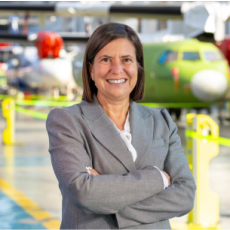What motivated you to join ATR in 2022?
I was heading up the NH90 program at Airbus Helicopters, a European cooperation between Leonardo, Airbus, and Fokker and as a strong believer in European cooperation, I really enjoyed working in both an international and European environment. Beyond this first reason, I believe we are at a pivotal moment in the industry. The challenges we face in decarbonizing aviation are immense, but they also present exciting opportunities for innovation. I am deeply motivated to lead a company that is not only vital to regional connectivity but also committed to pushing the boundaries of sustainable aviation, helping shape the future of our industry in a responsible and impactful way.
One of the key factors that also motivated me is my passion for taking on challenges. When I was approached for the ATR position, ATR was just getting out of the Covid period and therefore had to overcome many challenges while preparing for the future of aviation. I thrive in situations where innovation and transformation are needed and I see this as an opportunity to help steer the company through these challenges while driving positive changes.
You’ve said that ATR is a unique animal. Can you elaborate on what exactly makes this family of aircraft products unique and why that is?
ATR produces aircraft such as the ATR 42 and ATR 72 and has the full capabilities of an aircraft manufacturer - including design, production, and support & services. Despite being a smaller company with around 1,400 people, we manage the entire scope of operations like the larger OEMs. ATR's uniqueness lies in its mission to connect remote communities. ATR has always been driven by the idea that aviation can have a profound impact on connecting people and communities, especially in regions where accessibility is crucial and where our aircraft are often the only means of transportation. Regional aviation, in particular, plays a unique role in bridging those gaps, enabling economic development and providing essential connections.
We serve a diverse range of customers globally - from small operators with just one aircraft to large ones like Lion Air which has 77 aircraft. Our focus on cost-efficiency and versatility makes ATR the commercial success that we have seen over the last 40 years. We plan to ramp up rather than consolidate because we are currently the only turboprop manufacturer still producing aircraft. The industry once had six turboprop manufacturers in Europe, but now ATR remains the sole producer. ATR's success around the world is mainly linked to the aircraft itself, designed to be robust, capable of landing on all kinds of terrains, very versatile, offering a cost-effective solution for regional routes and yet offering comfort to passengers and technologies of larger aircraft. This positions us well for future growth, especially with the increasing focus on low-carbon and fuel-efficient aircraft. The shift towards sustainability is attracting interest, and while we remain humble about potential new entrants (as they will certainly come), we believe we currently have a strong position in the regional market.
ATR claims to be the lowest-emission regional aircraft on the market - how can the aircraft achieve lower CO2 emissions than its competitors?
One pivotal aspect that distinguishes ATR within the regional aviation landscape is its energy efficiency on short routes. On the CO2 emissions side, on a typical regional route of 250 to 300 nautical miles, ATRs only emit 69 g of CO2 per seat and per km, which is less than a hybrid car. In our pursuit of advancing the sustainability and fuel efficiency of our aircraft, ATR delivered in 2022 the first new PW127XT engine, which is a major leap forward in decarbonization. As a result of this evolution: the ATR 72-600 emits 45% less CO2 per trip than a regional jet of similar size, or 4,400 tons less CO2 per plane per year.
While this is a strong starting point, we want to continue to be at the forefront of decarbonization and have already conducted successful 100% SAF flights and in the second half of the decade, we plan to certify our aircraft to use 100% sustainable aviation fuel (SAF). Additionally, we are exploring hybrid aircraft technology, aiming to further reduce fuel consumption and emissions by integrating electric engines with traditional thermal propulsion systems. In that frame, we have launched a feasibility study on a hybrid-electric aircraft called the Evo. By mid-2025, we aim to determine if we have a viable propulsion solution that meets our fuel efficiency and emission reduction goals. If successful, the Evo aircraft could enter service beyond 2030, given the lengthy certification processes in our industry. This hybrid aircraft concept compatible with 100% SAF could significantly further lower CO2 emissions.
How do you successfully navigate the EU’s regulatory restrictions in Europe when trying to accelerate innovation in sustainability?
Working within the EU means dealing with multiple regulatory voices, which we need to navigate to achieve more sustainable aircraft. For example, SAF availability and production need regulatory support. The EU Commission has a key role in accelerating sustainable aviation by setting feedstock content regulations and incentivizing airlines to use more sustainable aircraft. This collaboration between industry and regulators is essential to overcome stringent regulations and support the industry's move towards sustainability.
How do the challenges manifest when operating regional and smaller aircraft, particularly in remote locations?
Our aircraft are designed to handle a diverse range of operating conditions, such as high and low altitudes and hot regions like Africa, but the main challenge is ensuring maximum flight time for our customers. The COVID-19 pandemic led to many grounded aircraft, but we've recovered to pre-COVID flight levels. Supply chain issues remain a significant challenge, especially with raw material shortages and the ramp-up pressures post-COVID. Supporting our suppliers, providing visibility on future demands, and working closely with them are crucial strategies to address these challenges and ensure our aircraft keep flying.
To combat ongoing supply chain challenges, we work with suppliers to prioritize tasks and sometimes support their activities. Providing visibility on future demand is critical, given ATR's smaller order book compared to larger companies. This transparency helps suppliers invest appropriately. Collaboration and being solution-oriented are essential. For example, we sometimes station our people at suppliers’ sites and even support raw materials acquisition for some smaller suppliers to ensure they can ramp up production. This hands-on approach together with a cooperation approach is necessary to overcome current supply chain disruptions.





